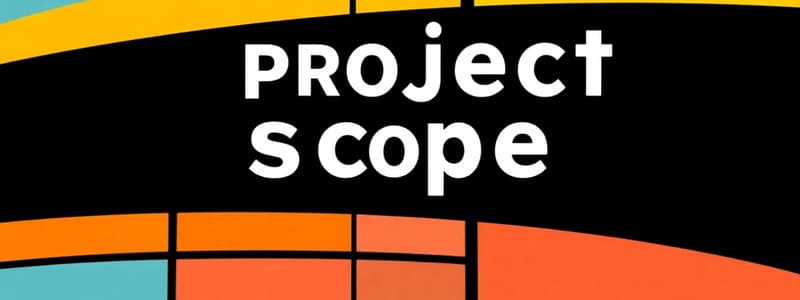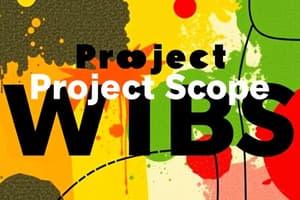Podcast
Questions and Answers
Which process is NOT a part of project scope management?
Which process is NOT a part of project scope management?
- Planning scope
- Controlling scope
- Estimating costs (correct)
- Validating scope
What is the primary purpose of 'collecting requirements' in project scope management?
What is the primary purpose of 'collecting requirements' in project scope management?
- To control changes to the project's scope
- To formalize acceptance of the project deliverables
- To define and document the features and functions of the project's deliverables (correct)
- To create the Work Breakdown Structure (WBS)
Which document is NOT a key input for 'defining scope'?
Which document is NOT a key input for 'defining scope'?
- Project charter
- Organizational process assets
- Requirements documentation
- Risk management plan (correct)
What does the 'scope baseline' include?
What does the 'scope baseline' include?
Which of the following is the MOST accurate description of a deliverable in project management?
Which of the following is the MOST accurate description of a deliverable in project management?
In the context of project scope management, what is the purpose of 'creating the WBS'?
In the context of project scope management, what is the purpose of 'creating the WBS'?
Which action is LEAST likely to be part of 'controlling scope'?
Which action is LEAST likely to be part of 'controlling scope'?
What is the main purpose of a Requirements Traceability Matrix (RTM)?
What is the main purpose of a Requirements Traceability Matrix (RTM)?
Which approach to developing a WBS involves reviewing WBSs from similar projects and tailoring it to your current project?
Which approach to developing a WBS involves reviewing WBSs from similar projects and tailoring it to your current project?
In project management, what is the purpose of validating scope?
In project management, what is the purpose of validating scope?
What is the FIRST thing the project team does in Planning Scope Management?
What is the FIRST thing the project team does in Planning Scope Management?
If a project's scope is too broad, what is a likely consequence?
If a project's scope is too broad, what is a likely consequence?
What is the purpose of a WBS dictionary?
What is the purpose of a WBS dictionary?
Why is it important to involve project team members in developing the WBS?
Why is it important to involve project team members in developing the WBS?
What does 'variance' mean in the context of controlling project scope?
What does 'variance' mean in the context of controlling project scope?
Your project is using internal staff for planning and execution instead of external consultants. Which approach is being emphasized?
Your project is using internal staff for planning and execution instead of external consultants. Which approach is being emphasized?
McDonald's spent $170 million on an intranet project before terminating it. What was the main problem?
McDonald's spent $170 million on an intranet project before terminating it. What was the main problem?
When is it MOST important to use an iterative process for defining requirements?
When is it MOST important to use an iterative process for defining requirements?
What is a common element that should be included in project scope statements?
What is a common element that should be included in project scope statements?
What is meant by Scope?
What is meant by Scope?
Flashcards
Scope (Project)
Scope (Project)
All the work involved in creating project products and the processes used.
Deliverable
Deliverable
A product produced as part of a project, like hardware, software, or documents.
Project Scope Management
Project Scope Management
Processes to define and control what is included in a project.
Planning Scope
Planning Scope
Signup and view all the flashcards
Collecting Requirements
Collecting Requirements
Signup and view all the flashcards
Defining Scope
Defining Scope
Signup and view all the flashcards
Creating the WBS
Creating the WBS
Signup and view all the flashcards
Validating Scope
Validating Scope
Signup and view all the flashcards
Controlling Scope
Controlling Scope
Signup and view all the flashcards
Scope Management Plan
Scope Management Plan
Signup and view all the flashcards
Requirement (Project)
Requirement (Project)
Signup and view all the flashcards
Requirements Management Plan
Requirements Management Plan
Signup and view all the flashcards
Requirements Traceability Matrix (RTM)
Requirements Traceability Matrix (RTM)
Signup and view all the flashcards
Project Scope Statement
Project Scope Statement
Signup and view all the flashcards
Work Breakdown Structure (WBS)
Work Breakdown Structure (WBS)
Signup and view all the flashcards
Decomposition
Decomposition
Signup and view all the flashcards
Work Package
Work Package
Signup and view all the flashcards
Scope Baseline
Scope Baseline
Signup and view all the flashcards
WBS Dictionary
WBS Dictionary
Signup and view all the flashcards
Scope Validation
Scope Validation
Signup and view all the flashcards
Study Notes
Project Scope Management
- Scope covers all tasks in creating project products, while a deliverable is the actual product, like hardware or planning documents.
- Project scope management includes processes for defining and controlling what is included (or not) in a project.
Project Scope Management Processes
- Planning scope involves determining how the project's scope and requirements will be managed.
- Collecting requirements means defining and documenting the features and functions of the products and the processes to create them.
- Defining scope includes reviewing the project charter, requirements documents, and organizational assets for the scope statement.
- Creating the WBS (Work Breakdown Structure) involves breaking major deliverables into manageable components.
- Validating scope is about formalizing the acceptance of project deliverables.
- Controlling scope focuses on managing changes to the project's scope throughout its duration.
Planning Scope Management Outputs
- Planning scope results in a scope management plan and a requirements management plan.
- The scope management plan is a subsidiary of the overall project management plan.
- It documents processes to prepare a detailed project scope statement and create, maintain, and approve the WBS.
Collecting Requirements (Phase 1)
- A requirement is a condition or capability needed in a product, service, or result to satisfy a business need.
- The requirements management plan details how project requirements are analyzed, documented, and managed.
- For some IT projects, requirements development is divided into elicitation, analysis, specification, and validation.
- An iterative approach is crucial for defining requirements, as they often lack clarity early on.
Methods for Gathering Requirements
- Common methods include interviews, focus groups, facilitated workshops, and group creativity techniques.
- Questionnaires, surveys, observation, prototyping, and software tools can also be used.
- Benchmarking involves collecting ideas by comparing project practices or product characteristics to other projects.
- Identifying who to ask is a key question.
Documenting Requirements
- Requirements documents can include text, images, diagrams, and videos.
- Requirements can be categorized by function, service, performance, quality, and training.
- The requirements management plan details the analysis, documentation, and management of project requirements.
- A requirements traceability matrix (RTM) lists requirements, attributes, and their current status.
Defining Scope Outcomes
- The project scope statement is the primary output.
- Key inputs include the project charter, requirements documentation, organizational process assets, project files, and lessons learned.
- Project scope statements should include a product scope description, acceptance criteria, and project deliverables information.
- Including scope-related information like project boundaries, constraints, and assumptions is helpful.
- The scope statement should reference supporting documents, like product specifications.
- As a project progresses, the scope should become more specific.
Work Breakdown Structure (WBS)
- A deliverable-oriented hierarchical decomposition of the work involved in a project
- Basis for planning and managing project schedules, costs, resources, and changes
- Decomposition: subdividing project deliverables into smaller pieces
- Work package: task at the lowest level of the WBS.
- The scope baseline includes the approved scope statement, WBS, and WBS dictionary.
Approaches to Developing WBSs
- Some organizations provide guidelines for preparing WBSs.
- The analogy approach tailors WBSs from similar projects as a starting point.
- The top-down approach starts with the project's largest items and breaks them down.
- The bottom-up approach starts with specific tasks and rolls them up into larger categories.
- Mind-mapping uses branches radiating from a core idea to structure thoughts.
WBS Dictionary and Scope Baseline
- Many WBS tasks require further explanation for team members to understand task requirements.
- The WBS dictionary documents detailed information about each WBS item.
- The scope baseline, which includes the approved scope statement, WBS, and WBS dictionary, is used to measure performance.
Guidelines for Creating a WBS & WBS Dictionary
- Each work unit should appear only once in the WBS.
- The work content is the sum of the items below it.
- A single person needs to be in charge.
- It should match how the work is going to be done, and be useful.
- Team members should be involved for consistency and buy-in.
- Scope work needs to be documented to ensure understanding of what is and isn't included
- TheWBS should be flexible for inevitable changes while maintaining control.
Avoiding Scope Issues
- Overly broad project scopes can cause problems.
- Scope creep and technology overemphasis led to a pharmaceutical firm's bankruptcy.
- McDonald's cancelled its intranet project after spending $170 million due to an overly ambitious scope.
Validating Scope Details
- Creating a good scope statement and WBS for a project can be difficult.
- Verifying project scope and minimizing changes can prove even more difficult.
- Scope validation entails formal acceptance of the completed project scope by stakeholders.
- Acceptance often involves customer inspection and approval of key deliverables.
Controlling Scope Details
- Scope control manages project scope changes.
- Goals include influencing factors causing scope changes, ensuring changes align with integrated change control, and managing changes.
- Variance is the difference between planned and actual performance.
Avoiding Scope Issues Best Practices
- Maintain a realistic scope by breaking down large projects.
- Involve users in project scope management and give them ownership.
- Use off-the-shelf hardware and software when possible, prioritizing business needs.
- Adhere to good project management processes, especially scope management.
Improving User Input
- Develop a good project selection process.
- Include users on the project team.
- Hold regular meetings with set agendas and sign-offs.
- Regularly deliver content and be mindful of delivery.
- Co-locate users and developers.
Studying That Suits You
Use AI to generate personalized quizzes and flashcards to suit your learning preferences.




